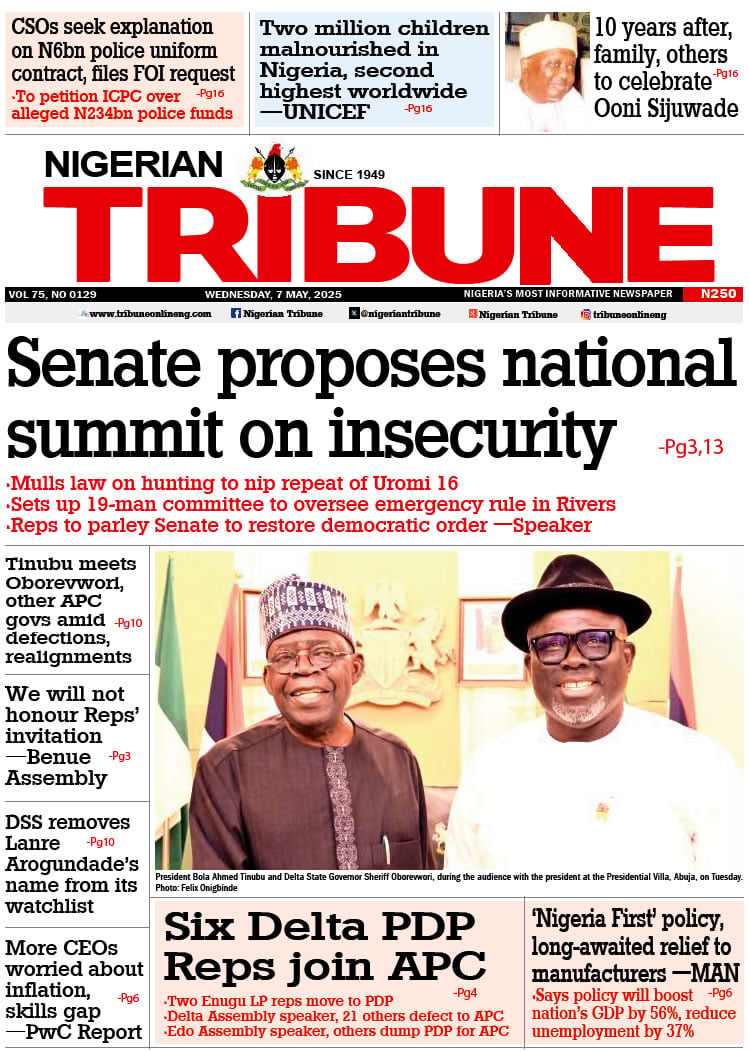Continued from last week
THE second and third levels will only be free in the early stages. the eventual aim should be, say, in twenty years’ time, to make these levels of education compulsory as well. Preparations for these levels do not need to start until after the actual launching of the first level. Though the second and third levels are expected to be free as from 1971 and 1970-71 academic session, respectively, they do not come into full swing until 1980 and 1985, respectively, when the eligible ones among the intakes of primary schools in 1974 enter institutions of learning at these levels throughout the Federation.
The reason for making the second and third levels free in 1971 and 1970/71 is obvious. Teachers will have to be trained in much larger numbers than ever before, as from the beginning of 1972. If these teachers are to possess the required basic qualifications, they should have done certain approved courses at the secondary grammar and secondary commercial schools. Besides, if the training of the teachers is to be sound, and if instructions at the second level generally are to be of the standards requisite for our purposes, the ratio of graduate to non-graduate teachers at the second level should be as high as possible, and in any case not below one to three.
Furthermore, by 1985, many Nigerian graduates at the third level would be required to man a large number of institutions of higher learning, not to talk of the considerable number which will be required, immediately and from time to time, to take charge of all our productive and development activities.
It is for all these reasons-that it is imperative that the second and third levels should be free as from 1971, and the 1970/71 academic session, so as to ensure that all available talents in the country are mobilised for the ends in view. This is the only way of guaranteeing a continuous flow of Nigerian graduates from 1971/72 until 1980 to 1985 when very large numbers of them would be required in the vastly increased number of second and third level institutions. The alternative to this policy would be to continue to import expatriate teachers, with adverse consequences on our local spending, and on our balance of payments. It will be noticed from Appendix I that provisions are made for secondary vocational schools and for a four-year university course.
We consider these very necessary. In the one case, children leaving primary schools, at the age of about twelve, are too tender to embark on any gainful employment. The three years in vocational schools would equip them physically, mentally, and technically to earn a living for themselves. In the other case, I regard the universities as much better places for doing the pre-University Courses which are now being done in the sixth form in grammar schools. The universities, it will be agreed, possess better facilities, and, comparatively, more competent staff than could be available in the secondary grammar and commercial schools. Above all, I am authoritatively informed that, other things being equal, students, who now take a preliminary course in our universities, do better in their undergraduate courses than those who take the sixth form course in the grammar schools.
The projected recurrent and capital costs of this great scheme are shown in Tables 3-7, for the period of 20 years, from 1971 to 1990.
The relation of the aggregate projected costs to our aggregate projected recurrent revenues from direct and indirect taxation, for the same period, is shown in Tables 7 and 8. Three points call for brief comments here.
Firstly, the period of 20 years has been chosen, partly because it is now the fashion to have a perspective plan for that period broken into four quinquennial operative plan periods, and mainly because we need that period to enable us to estimate how the scheme, in terms of costs, would behave over its first full span. In this connection, it must be mentioned that those, of the first batch of primary school children enrolled in 1974, who are able to do so would be completing their third level courses from the end of 1988 to the end of 1990.
Secondly, while during the first five years of the scheme, more money would be spent in the ‘southern states, it is clear from Table 7 that from 1980 onwards, the northern states would come into their own, and the final phase in the closing of the educational gap between the north and the south would have begun in real earnest. In this connection, Tables 1 and 2 are of considerable interest. Furthermore, from Column 4 of these Tables, it can be deduced-and the breakdown Tables of this Column, which I have in my possession but which for reasons of space cannot be included in this book, establish the point – that by the beginning of 1985, every State in the country would have at least one university.
Thirdly, it will be seen from Tables 7 and 8 that, Horn 1970171 to 1975176., the total estimated annual recurrent cost is less than one- fourth of the total projected annual recurrent revenue.
It may be mentioned, in passing, that, with judicious planning, a lot of savings could be effected on capital accounts. For while in Appendix I at page III, £300 is estimated as the cost of one primary school classroom. I am informed by the Ibadan Local School Board that in Ibadan city, in 1969,130 classrooms were erected at a cost of between £180 and £200 each. Most of the classrooms were built with brick and cement, and were financed by the Parent/Teacher Associations in Ibadan.
It will be recalled that I have advocated full employment as one of the cardinal objectives of the people’s republic of Nigeria. There can, therefore, be no question of unemployment for our large multitude of educated youths who would begin to leave their respective institutions of learning as from 1982.
With regard to adult education, by the time it is launched in 1976, there would be more than enough patriotic voluntary workers – teachers, health officers, vocational school pupils etc.,-to make the scheme work. The capital outlay would be minimal, and would be offset by proceeds from the sale of literature and journals specially prepared for the adult literates.
To be continued






